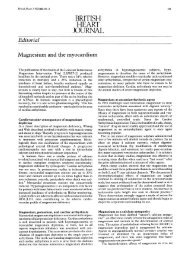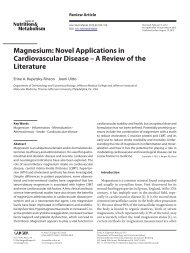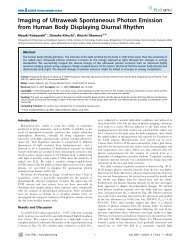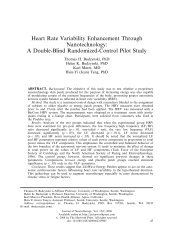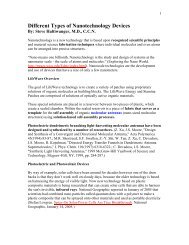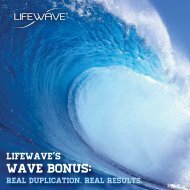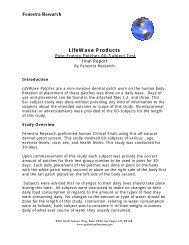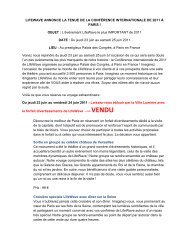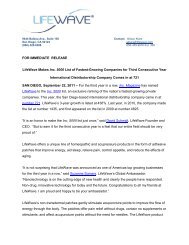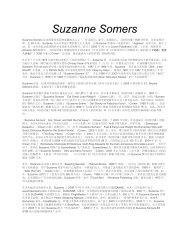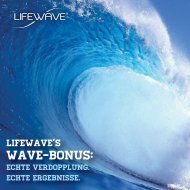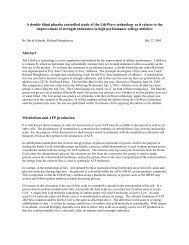tefillin: an ancient acupuncture point prescription for ... - Kosher Torah
tefillin: an ancient acupuncture point prescription for ... - Kosher Torah
tefillin: an ancient acupuncture point prescription for ... - Kosher Torah
Create successful ePaper yourself
Turn your PDF publications into a flip-book with our unique Google optimized e-Paper software.
JOURNAL OF CHINESE MEDICINE NUMBER 70 OCTOBER 2002<br />
TEFILLIN: AN ANCIENT<br />
ACUPUNCTURE POINT<br />
PRESCRIPTION FOR<br />
MENTAL CLARITY<br />
by Steven Schram<br />
Introduction<br />
Tefillin is <strong>an</strong> <strong>an</strong>cient Jewish prayer ritual that uses two small<br />
leather boxes, each attached to a long, 9mm wide, leather<br />
strap. One box is placed on the biceps of the weaker arm<br />
while the second is placed on the head. The biceps strap is<br />
tightly wound along the arm in a carefully prescribed<br />
m<strong>an</strong>ner. The back of the head strap is tied in a knot <strong>an</strong>d<br />
carefully placed at the base of the skull.<br />
The acknowledged purpose of the <strong>tefillin</strong> is to raise<br />
spiritual consciousness of the men who wear it. If we<br />
examine where the knots <strong>an</strong>d wrappings are placed from a<br />
TCM <strong>point</strong> of view, it appears that the <strong>tefillin</strong> <strong>an</strong>d wraps<br />
<strong>for</strong>m a potent <strong>acupuncture</strong> <strong>point</strong> <strong>for</strong>mula focused on the<br />
Governing vessel (Du Mai) <strong>an</strong>d aimed at elevating the spirit<br />
<strong>an</strong>d clearing the mind.<br />
The head <strong>tefillin</strong><br />
The head <strong>tefillin</strong> is the simplest to examine as its positioning<br />
is very explicitly defined. The box is always placed midway<br />
between the eyes with the base of the <strong>tefillin</strong> placed on the<br />
<strong>for</strong>ehead so the bottom edge remains just inside the hairline.<br />
The diagram below shows this location as Shenting<br />
DU-24. The weight of the box (several ounces) is a little<br />
Shenting DU-24<br />
Sh<strong>an</strong>gxing DU-23<br />
Baihui DU-20<br />
Fengfu DU-16<br />
further back at Sh<strong>an</strong>gxing DU-23; the exact placement of<br />
weight will vary slightly depending on the size of the box.<br />
The knot in the back (where the strap is tied together) is placed<br />
just under the external occipital protuber<strong>an</strong>ce. This corresponds<br />
to Fengfu DU-16. Once the knot is in place, the side<br />
straps are tightened down. This creates a steady upward<br />
pressure into Fengfu DU-16 <strong>an</strong>d more pressure on both<br />
Sh<strong>an</strong>gxing DU-23 <strong>an</strong>d Shenting DU-24.<br />
Binding the left arm<br />
I explored the four major variations in wrapping procedures:<br />
Chassidic 1 , Sefardim 2 , Sefard, <strong>an</strong>d Ashkenazi 3 . By<br />
experimenting on myself with these different wrapping<br />
procedures, I was able to map out the signific<strong>an</strong>t <strong>acupuncture</strong><br />
<strong>point</strong>s that are stimulated through the procedure (see<br />
over page).<br />
Point Selection <strong>for</strong> Analysis<br />
Along with the three skull <strong>point</strong>s already discussed, the<br />
<strong>tefillin</strong> wrap contacts a good number of the over 50 <strong>acupuncture</strong><br />
<strong>point</strong>s on the arm 6 . However, we will limit our<br />
<strong>point</strong> <strong>an</strong>alysis to those that have a more subst<strong>an</strong>tive influence<br />
on the mind <strong>an</strong>d spirit 7 . In addition, because the<br />
pressure of the arm wrap is mostly felt at <strong>point</strong>s on the<br />
5
JOURNAL OF CHINESE MEDICINE NUMBER 70 OCTOBER 2002<br />
Ashkenazi 4<br />
Sefard<br />
Sefardim<br />
Chassidic 5<br />
outside of the arm bones we have excluded general <strong>point</strong>s<br />
on the Pericardium <strong>an</strong>d Triple Burner ch<strong>an</strong>nel. That leaves<br />
us with the <strong>point</strong>s shown on the Tables to the right. The<br />
<strong>point</strong>s are listed in the order in which they are initially<br />
stimulated.<br />
Tefillin <strong>point</strong> <strong>for</strong>mula comparison<br />
A set of <strong>point</strong> <strong>for</strong>mulas <strong>for</strong> each of the methods arises from<br />
our <strong>an</strong>alysis:<br />
Chassidic: Ti<strong>an</strong>fu LU-3, Shaohai HE-3, Chize LU-5, Zhizheng<br />
SI-7, Wenliu L.I.-7, Pi<strong>an</strong>li L.I.-6, Lieque LU-7, Shenmen HE-7,<br />
Taiyu<strong>an</strong> LU-9, Shenting DU-24, Sh<strong>an</strong>gxing DU-23, Fengfu<br />
DU-16, Hegu L.I.-4, Houxi SI-3, Pericardium ch<strong>an</strong>nel.<br />
Ashkenazi: Ti<strong>an</strong>fu LU-3, Zhizheng SI-7, Wenliu L.I.-7, Pi<strong>an</strong>li<br />
L.I.-6, Lieque LU-7, Shenmen HE-7, Taiyu<strong>an</strong> LU-9, Shenting<br />
DU-24, Sh<strong>an</strong>gxing DU-23, Fengfu DU-16, Hegu L.I.-4, Houxi<br />
SI-3, Pericardium ch<strong>an</strong>nel.<br />
Sefard: Ti<strong>an</strong>fu LU-3, Shaohai HE-3, Chize LU-5, Zhizheng<br />
SI-7, Wenliu L.I.-7, Pi<strong>an</strong>li L.I.-6, Lieque LU-7, Shenmen HE-7,<br />
Taiyu<strong>an</strong> LU-9, Shenting DU-24, Sh<strong>an</strong>gxing DU-23, Fengfu<br />
DU-16, Hegu LI.-4, Houxi SI-3, Pericardium ch<strong>an</strong>nel.<br />
Sefardim:Ti<strong>an</strong>fu LU-3, Shaohai HE-3, Chize LU-5, Zhizheng<br />
SI-7, Wenliu L.I.-7, Pi<strong>an</strong>li L.I.-6, Lieque LU-7, Shenmen HE-7,<br />
Taiyu<strong>an</strong> LU-9, Shenting DU-24, Sh<strong>an</strong>gxing DU-23, Fengfu<br />
DU-16, Hegu L.I.-4, Houxi SI-3, Pericardium ch<strong>an</strong>nel.<br />
Points Fengfu DU-16, Ti<strong>an</strong>fu LU-3, Houxi SI-3, Hegu<br />
6
JOURNAL OF CHINESE MEDICINE NUMBER 70 OCTOBER 2002<br />
Stimulation of <strong>acupuncture</strong> <strong>point</strong>s on the arm<br />
Chassidic Ashkenazi Sefard Sefardim<br />
LU-3 X X X X<br />
HE-3 X X X<br />
LU-5 X X X<br />
SI-7 X X X X<br />
LI-6 X X X X<br />
LI-7 X X X X<br />
LU-7 X X X X<br />
HE-7 X X X X<br />
LU9 X X X<br />
Stimulation of <strong>acupuncture</strong> <strong>point</strong>s on the head<br />
Chassidic Ashkenazi Sefard Sefardim<br />
DU-24 X X X X<br />
DU-23 X X X X<br />
DU-16 X X X X<br />
Stimulation of <strong>acupuncture</strong> <strong>point</strong>s on the h<strong>an</strong>d<br />
Chassidic Ashkenazi Sefard Sefardim<br />
SI-3 X X X X<br />
L.I.-4 X X X X<br />
Pericardium X X X X<br />
L.I.-4 <strong>an</strong>d the Pericardium ch<strong>an</strong>nel (from wrapping the<br />
middle finger) always have more stimulation th<strong>an</strong> others.<br />
Also, wrist <strong>point</strong>s including Taiyu<strong>an</strong> LU-9 <strong>an</strong>d Shenmen<br />
HE-7 receive stronger pressure compared to the other <strong>point</strong>s<br />
on the body of the <strong>for</strong>earm. Thus a more honed <strong>for</strong>mula of<br />
the more signific<strong>an</strong>t <strong>point</strong>s is as follows:<br />
Chassidic: Ti<strong>an</strong>fu LU-3, Fengfu DU-16, Lieque LU-7, Shenmen<br />
HE-7, Taiyu<strong>an</strong> LU-9, Houxi SI-3, Hegu L.I.-4, Pericardium<br />
ch<strong>an</strong>nel.<br />
Ashkenazi: Ti<strong>an</strong>fu LU-3, Fengfu DU-16, Lieque LU-7, Shenmen<br />
HE-7, Houxi SI-3, Hegu L.I.-4, Pericardium ch<strong>an</strong>nel.<br />
Sefard: Ti<strong>an</strong>fu LU-3, Fengfu DU-16, Lieque LU-7, Shenmen<br />
HE-7, Taiyu<strong>an</strong> LU-9, Houxi SI-3, Hegu L.I.-4, Pericardium<br />
ch<strong>an</strong>nel.<br />
Sefardim: Ti<strong>an</strong>fu LU-3, Fengfu DU-16, Lieque LU-7, Shenmen<br />
HE-7, Taiyu<strong>an</strong> LU-9, Houxi SI-3, Hegu L.I.-4, Pericardium<br />
ch<strong>an</strong>nel.<br />
Note that there is essential agreement <strong>an</strong>d overlap between<br />
the honed <strong>point</strong> <strong>prescription</strong>s called <strong>for</strong> by the four<br />
different <strong>tefillin</strong> wrapping techniques. The only difference<br />
is that the the Ashkenazi style excludes Taiyu<strong>an</strong> LU-9. This<br />
should have little clinical signific<strong>an</strong>ce, given the scope of<br />
the remaining <strong>point</strong>s in the <strong>for</strong>mula.<br />
Point <strong>an</strong>d ch<strong>an</strong>nel discussion<br />
• The Governing Vessel (Du Mai) is <strong>an</strong> extra-ordinary<br />
meridi<strong>an</strong> that runs up the spine <strong>an</strong>d penetrates the brain. It<br />
is well known <strong>for</strong> its ability to treat psychiatric disorders<br />
<strong>an</strong>d influence the mind 8 . The Spiritual action of <strong>point</strong>s on<br />
the Governing vessel c<strong>an</strong> be explained because it has the<br />
closest relationship with the brain, which, according to pre-<br />
Inner Classic <strong>an</strong>d later Daoist traditions is considered to be<br />
the seat of the spirit. A further connection of the Governing<br />
Vessel to Spirit is found from its <strong>an</strong>terior pathway, which<br />
directly connects it to the more traditional home of Spirit,<br />
the Heart.<br />
• Fengfu DU-16 (Wind M<strong>an</strong>sion) is also known as Gui Zhen,<br />
which tr<strong>an</strong>slates as Ghost Pillow 9 . It has also a <strong>point</strong> in the<br />
Window of Heaven category 10 . According to ch<strong>an</strong>nel theory,<br />
Fengfu DU-16 is where the Governing vessel penetrates the<br />
brain. It is one of two <strong>point</strong>s (the other being Baihui DU-20)<br />
that directly nurture the brain <strong>an</strong>d spinal cord. The therapeutic<br />
scope of Fengfu DU-16 is quite wide <strong>an</strong>d it is known<br />
to strongly benefit both concentration <strong>an</strong>d memory. It also<br />
treats dizziness, stroke, aphasia <strong>an</strong>d headache. In psychotic<br />
patients, it reduces the desire <strong>for</strong> suicide <strong>an</strong>d <strong>for</strong> selfmutilation.<br />
Fengfu DU-16 is also is a <strong>point</strong> on Y<strong>an</strong>g Linking<br />
vessel that connects all heavenly rising Y<strong>an</strong>g energy.<br />
• Sh<strong>an</strong>gxing DU-23 (Upper Star) is also known as Gui T<strong>an</strong>g<br />
which tr<strong>an</strong>slates as Ghost Hall. It treats psychosis, headaches,<br />
<strong>an</strong>d nearsightedness. It is also the root of the sinus<br />
<strong>an</strong>d is very effective in treating loss of smell. Since the<br />
olfactory nerve is the first of the 12 cr<strong>an</strong>ial nerves, its use in<br />
this m<strong>an</strong>ner clearly indicates a profound effect on the brain.<br />
• Shenting DU-24 (Spirit Court) is also known as Ti<strong>an</strong>ting<br />
(Courtyard of Heaven) calms the mind <strong>an</strong>d bal<strong>an</strong>ces the<br />
spirit. It c<strong>an</strong> be used to treat <strong>an</strong>y mental disease 11 . Like other<br />
<strong>point</strong>s of the Governing vessel, it has a strong action on<br />
calming the spirit <strong>an</strong>d treating epilepsy <strong>an</strong>d other m<strong>an</strong>ia<br />
disorders. According to Daoist tradition, this <strong>point</strong> c<strong>an</strong><br />
connect directly to Niw<strong>an</strong> (Mud Ball), which is considered<br />
to be the location of the physical basis of the spirit. “The qi<br />
of the Heart is connected with the Niw<strong>an</strong> Palace above.” 12<br />
The signific<strong>an</strong>ce of Niw<strong>an</strong>, also known as Hu<strong>an</strong>gting (Yellow<br />
Courtyard) is emphasized in the Classic on the Central<br />
Void in the Inner Sphere which said, “The origin of essencespirit<br />
in the brain is also called Niw<strong>an</strong>” <strong>an</strong>d also “The entire<br />
spirit that expresses in the face has its origin in Niw<strong>an</strong>”. 13<br />
• Houxi SI-3 (Back Ravine) is the most import<strong>an</strong>t <strong>point</strong> on the<br />
h<strong>an</strong>d with respect to the mind because it is the opening<br />
<strong>point</strong> to the Governing vessel. It frees <strong>an</strong>d moves qi in the<br />
Governing vessel <strong>an</strong>d acts as a multiplier that strengthens<br />
the actions of the vessel’s <strong>point</strong>s (Fengfu DU-16, Sh<strong>an</strong>gxing<br />
DU-23 <strong>an</strong>d Shenting DU-24) already stimulated by the head<br />
<strong>tefillin</strong>. Alone or in combination with other <strong>point</strong>s, it clears<br />
the spirit, treats <strong>an</strong>y kind of psychosis including loss of<br />
memory, dementia, sorrow or fear.<br />
• Zhizheng SI-7 (Br<strong>an</strong>ch of the Upright) is the luo connecting<br />
<strong>point</strong> of the Small Intestine ch<strong>an</strong>nel, connecting to the Heart<br />
ch<strong>an</strong>nel. It has a pronounced effect on regulating <strong>an</strong>d<br />
calming the shen. It helps relieve <strong>an</strong>xiety, fear <strong>an</strong>d sorrow.<br />
• Hegu L.I.-4 (Union Valley) is the comm<strong>an</strong>d <strong>point</strong> of the<br />
head <strong>an</strong>d face. It is used to treat all conditions of the head,<br />
face, sinuses or eyes. It has a powerful calming <strong>an</strong>d <strong>an</strong>tispasmodic<br />
effect <strong>an</strong>d is widely used in relieving pain. It has<br />
a strong influence on the mind <strong>an</strong>d has the ability to soothe<br />
the mind <strong>an</strong>d calm <strong>an</strong>xieties. It is widely used in combination<br />
with other <strong>point</strong>s because it strongly enh<strong>an</strong>ces the<br />
7
JOURNAL OF CHINESE MEDICINE NUMBER 70 OCTOBER 2002<br />
movement of qi <strong>an</strong>d strengthens the effect of other <strong>point</strong>s in<br />
the <strong>point</strong> <strong>for</strong>mula.<br />
• Pi<strong>an</strong>li LI-6 (Veering Passage) <strong>an</strong>d Wenliu LI-7 (Warm<br />
Flow) are both used together to treat <strong>an</strong>y mental disorder,<br />
<strong>an</strong>d in particular, improve the clarity of the spirit.<br />
• Ti<strong>an</strong>fu LU-3 (Heavenly Residence) is the first <strong>point</strong> stimulated<br />
when one starts the process of wrapping the <strong>tefillin</strong>. It<br />
is <strong>an</strong> import<strong>an</strong>t <strong>point</strong> in treating the mind <strong>an</strong>d is in a special<br />
<strong>point</strong> category called Window of Heaven <strong>point</strong>s. The <strong>point</strong>s<br />
in this grouping all have psychological <strong>an</strong>d spiritual benefits.<br />
• Chize LU-5 (Cubit Marsh, aka Gui T<strong>an</strong>g: Ghost Hall) treats<br />
p<strong>an</strong>ic <strong>an</strong>d <strong>an</strong>xiety. As a Ghost <strong>point</strong>, it has the effect of clearing<br />
the mind <strong>an</strong>d enh<strong>an</strong>cing concentration. It c<strong>an</strong> promote qi <strong>an</strong>d<br />
blood circulation in the head <strong>an</strong>d face. 14 All wrap techniques<br />
except Ashkenazi intersect <strong>an</strong>d stimulate this <strong>point</strong><br />
• Lieque LU-7 (Broken Sequence) is the comm<strong>an</strong>d <strong>point</strong> of<br />
the head <strong>an</strong>d neck <strong>an</strong>d it is capable of improving circulation<br />
in the brain. Its primary mental function is related to stimulating<br />
memory. It is both the Luo <strong>point</strong> to the Lung ch<strong>an</strong>nel<br />
connecting to the Large Intestine ch<strong>an</strong>nel <strong>an</strong>d also the<br />
opening <strong>point</strong> <strong>for</strong> the Conception vessel.<br />
• Taiyu<strong>an</strong> LU-9 (Great Abysss aka Gui Xia: Ghost Heart) is<br />
the yu<strong>an</strong>-source of the Lung ch<strong>an</strong>nel. It treats agitation <strong>an</strong>d<br />
is very calming to the mind.<br />
• Shaohai HE-3 (Lesser Sea) improves memory <strong>an</strong>d decreases<br />
fears <strong>an</strong>d <strong>an</strong>xiety.<br />
• Shenmen HE-7 (Spirit Gate) treats all mental disorders<br />
equally well. It is a primary <strong>point</strong> to calm the heart <strong>an</strong>d<br />
mind, bal<strong>an</strong>ce the spirit <strong>an</strong>d improve memory <strong>an</strong>d concentration.<br />
Because Lingdao HE-4, Tongli HE-5, Yinxi HE-6<br />
<strong>an</strong>d Shenmen HE-7 are located very close together, windings<br />
like the Chassid technique <strong>for</strong> the lower arm are more likely<br />
to stimulate all of these <strong>point</strong>s.<br />
• The Pericardium Ch<strong>an</strong>nel calms the heart <strong>an</strong>d steadies the<br />
mind. Even though no specific <strong>point</strong>s are stimulated, the<br />
wrapping of the middle finger stimulates this ch<strong>an</strong>nel in<br />
general. The Sephardim wrap stimulates this ch<strong>an</strong>nel the<br />
strongest.<br />
Discussion<br />
If someone h<strong>an</strong>ded <strong>an</strong> acupuncturist the above <strong>point</strong> <strong>for</strong>mula<br />
<strong>an</strong>d asked what was being treated, there is little doubt<br />
that mental <strong>an</strong>d shen issues would be a strong part of the<br />
pattern. What is surprising is that such a <strong>point</strong> <strong>for</strong>mula<br />
would be found in a non-Chinese procedure that has been<br />
continuously practised <strong>for</strong> m<strong>an</strong>y thous<strong>an</strong>ds of years. It may<br />
be that the originators of the <strong>tefillin</strong> ritual had some inkling<br />
of its special effects, even though they may have lacked the<br />
depth <strong>an</strong>d specific knowledge we have today.<br />
The order of wrapping is also very interesting in that the<br />
entire arm is not wrapped at once, but stopped prior to<br />
stimulating the h<strong>an</strong>d <strong>point</strong>s of the Pericardium Ch<strong>an</strong>nel as<br />
well as Houxi SI-3 <strong>an</strong>d Hegu L.I.-4. These <strong>point</strong>s are added<br />
only after Fengfu DU-16, Sh<strong>an</strong>gxing DU-23 <strong>an</strong>d Shenting<br />
DU-24 have been added to the <strong>point</strong> <strong>for</strong>mula. Perhaps this<br />
is a subtle clue to our present day practice of <strong>acupuncture</strong>,<br />
recommending to us that we add the <strong>point</strong> multipliers<br />
towards the end of our treatment protocol. This concept<br />
deserves further exploration.<br />
Regardless of the belief system behind the procedure, it<br />
seems clear that putting on <strong>tefillin</strong> is a unique way of stimulating<br />
a very precise set of <strong>acupuncture</strong> <strong>point</strong>s that appears<br />
designed to clear the mind <strong>an</strong>d harmonise the spirit.<br />
References<br />
1 Personal instruction from Chassid Rabbi D<strong>an</strong>iel Dah<strong>an</strong> 718-<br />
851-2617<br />
2 Personal instruction from Sefardim Rabbi Gideon Shloush at<br />
Talmud <strong>Torah</strong> Adereth El, 212-685-0241<br />
3 Personal instructions given to me 37 years ago by Ashkenazi<br />
Rabbi Elihu Eleph<strong>an</strong>t<br />
4 Oter Yisrael, 31 K<strong>an</strong>fei Nesharim St. Sapir Center, Jerusalem:<br />
http://www.shemayisrael.co.il/<strong>tefillin</strong>/index.htm<br />
5 Detailed instruction c<strong>an</strong> be found at http://<br />
www.sichosinenglish.org/books/bar-mitzvah/05.htm<br />
6 Ellis, Wisem<strong>an</strong>, Bose, Paradigm, Fundamentals of Chinese<br />
Acupuncture, Paradigm Publications, 1991 p 48 & 50.<br />
7 Sionneau, Philippe, The Treatment of Psycho-emotional<br />
Disorders With Traditional Chinese Acupuncture, Private<br />
Seminar, New York City, June 8th & June 9th, 2002, presented<br />
by Soho Herbs <strong>an</strong>d Acupuncture<br />
8 Deadm<strong>an</strong>, P <strong>an</strong>d Al-Khafaji, M, The Treatment of Psycho-<br />
Emotional Disturb<strong>an</strong>ce by Acupuncture with particular<br />
reference to the Du Mai, Journal of Chinese Medicine, J<strong>an</strong>uary<br />
1995 47 p.30<br />
9 Yong, H., Treating Mental Disorders with Acupuncture <strong>an</strong>d<br />
Moxibustion: An Introduction to the Achievement of Hu Lingxi<strong>an</strong>g,<br />
Int’l J. of Clinical Acupuncture, 1995 6:2, 143 (Sun Simiao<br />
of the T<strong>an</strong>g Dynasty <strong>an</strong>d Xu Qiu-fu of the Song Dynasty<br />
each proposed 13 Ghost <strong>point</strong>s. GV-16 is in both systems.)<br />
10 Deadm<strong>an</strong>, P <strong>an</strong>d Al-Khafaji, M, The Points of the Window of<br />
Heaven, Journal of Chinese Medicine, September 1998, 43.<br />
11 Sionneau, Philippe, Ibid.<br />
12 Classic Collected Wisdom by Master Magic Sword, quoted in<br />
Deadm<strong>an</strong>, P <strong>an</strong>d Al-Khafaji, M, A M<strong>an</strong>ual of Acupuncture,<br />
Journal of Chinese Medicine Publications, September 1998.<br />
13 Quoted in Deadm<strong>an</strong>, P <strong>an</strong>d Al-Khafaji, M, A M<strong>an</strong>ual of<br />
Acupuncture, Journal of Chinese Medicine Publications,<br />
September 1998.<br />
14 Ling Shu, Chapter 21.<br />
8



